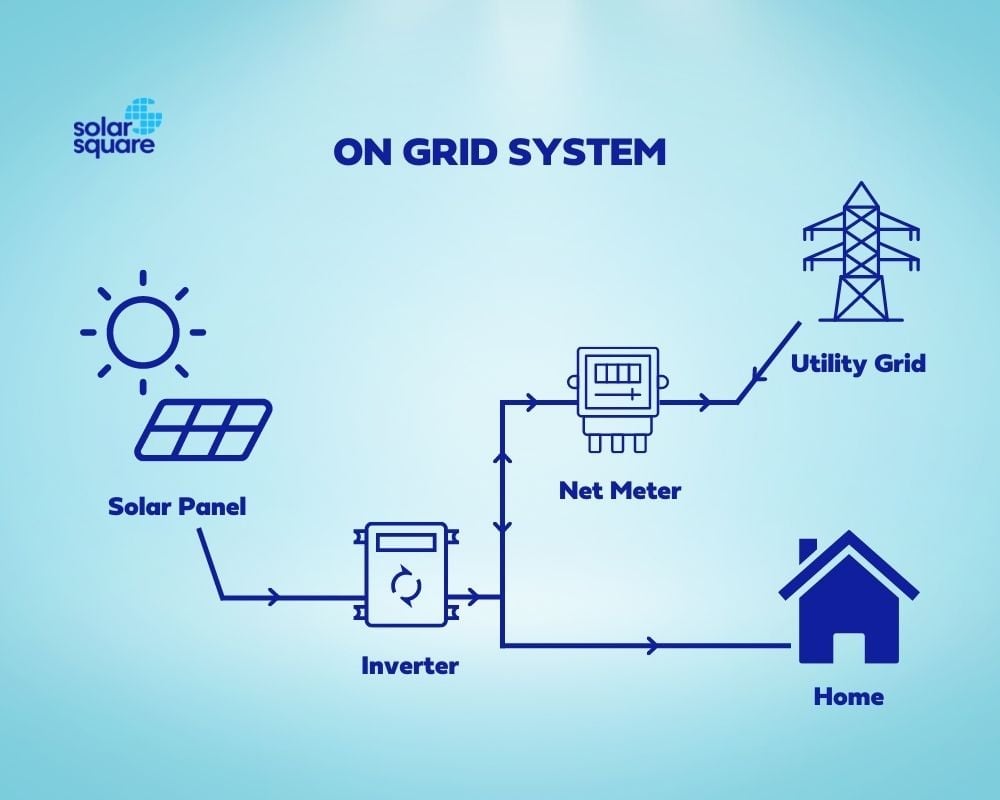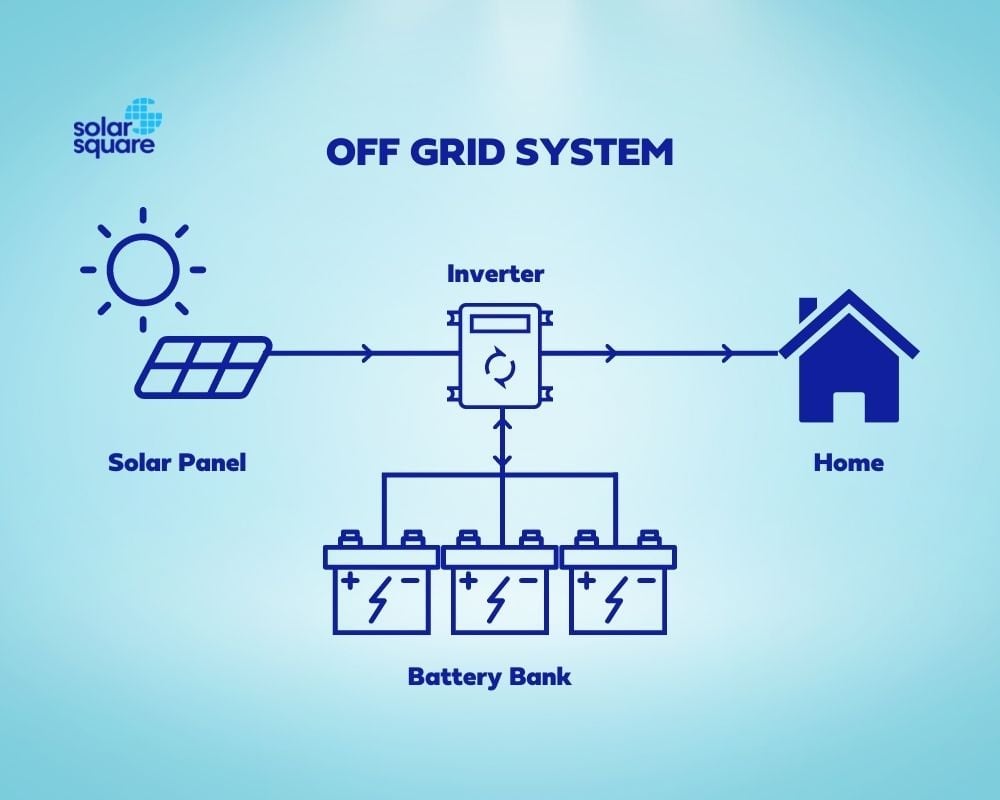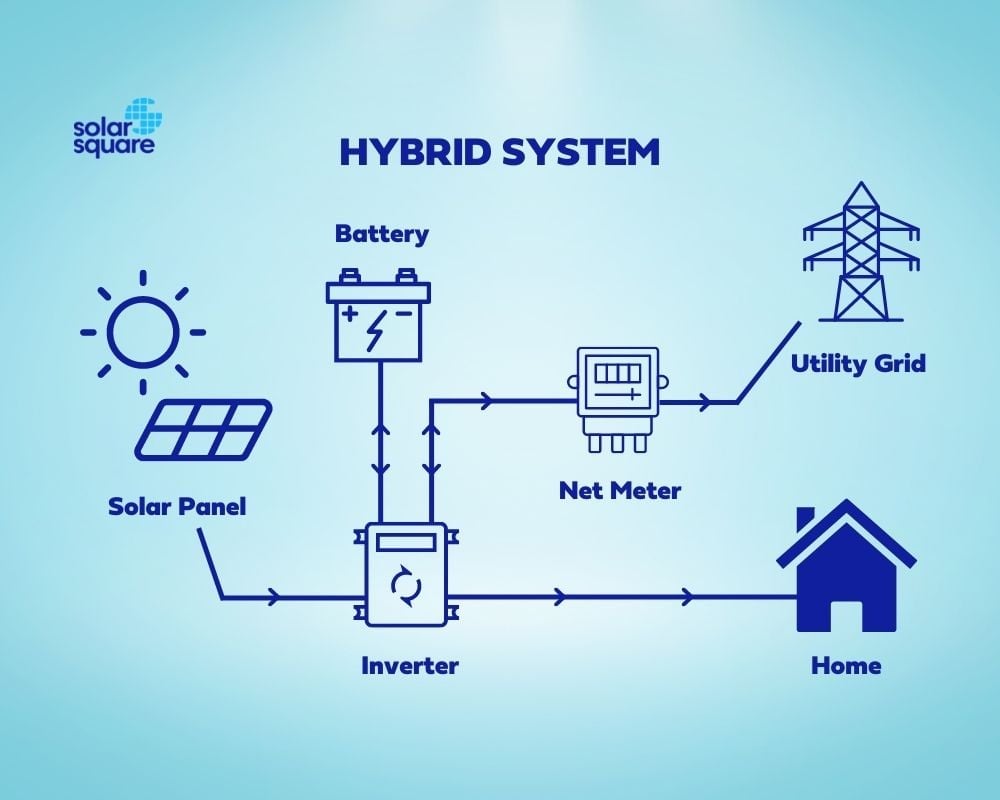
A solar power system is an appropriate arrangement of all the components of solar systems to produce consumable electricity. The primary motive of setting up a solar power plant is to ensure power independence and lower the commercial electricity bill.
A solar power plant includes large and small systems ranging from 1 kilowatt to megawatts. There are multiple technologies for solar power plants, but photovoltaic systems are the most efficient and are broadly used to convert sunlight into electricity.
Having proper knowledge about all the types of solar systems is crucial to making an intelligent decision about installing the right solar panel.
Different types of Solar Systems
Many people are switching from using conventional electricity systems to set up their individual electricity production units.
There are basically three types of solar electricity generation systems available in the market. Dive in for details!
1. On-grid solar electric system

An on-grid solar power plant is connected to the utility grid. These solar PV systems generate electricity only when the utility power grid is available.
Therefore, they can only function when an electricity grid is available. This solar power plant is excellent for people who want to save money on their electricity bills.
Through this system, people can transfer extra electricity to the grid. The bidirectional meter records this power transfer so that people can easily use power without paying any extra amount.
2. Off-grid solar electric system

An off-grid solar power plant is connected to a battery to conserve the converted DC for convenient usage. This system is appropriate for areas that lack commercial power supply or where frequent power cuts occur.
The off-grid solar system requires a solar panel, charge controller, battery bank, and a solar inverter for converting DC from solar panel to AC.
The battery bank stores extra power captured from sun rays during the day to ensure an uninterrupted power supply during the night or in the absence of sunlight.
3. Hybrid solar electric system

This system is a combination of both off-grid and on-grid solar systems. In this system, the solar system is connected to both a grid and a set of battery banks to conserve and use energy.
Through this system, people can maximise their power consumption without increasing their electricity bills. This is the most efficient and sustainable option for generating and using electricity for future purposes.
Technologies of Solar Power Solutions
There are three major types of solar power solutions for generating usable electricity from sun rays. Each solar system requires a different kind of setup and surface area for efficient performance. These systems are discussed below in detail.
1. Thermal Solar Power Solutions
This solar solution uses the sun’s heat to produce electricity. In this, multiple solar collectors reflect the sun’s rays to a point. This process assists in obtaining high temperatures for generating consumable electricity.
The generation of heat in this process increases steam in the fluid, which then turns the turbine to produce electricity.
The tracking system for the thermal solar power generation technique catches a sufficient amount of sunlight even when the sun changes its position.
2. Concentrated Solar Power Solutions
These solar power solutions use lenses, tracking systems, and mirrors to concentrate the solar energy.
Through this system, the high-intensity solar energy converts to room temperature. This heat then runs the turbines or generates electricity through engines.
3. Photovoltaic Solar Power Solutions
This is the most widely used technology for generating solar electricity. In this process, solar panels collect solar energy in the form of direct current and transform it into consumable electricity with the help of a solar inverter.
Solar Systems for Commercial Purposes
Ground-mounted solar power plants are mostly used for commercial purposes of solar electricity. These solar power plants require a huge area of land to set up solar panels that can capture enough sunlight to generate the required units of electricity for sale.
The following factors determine the profitability of using this solar electricity system:
- Area of the project.
- Location of the power plant.
- The tilt of the solar panels.
- Technical specifications of the cables.
Top 5 Benefits of Solar System in India
The solar power system offers the most sustainable energy development method as it is abundantly available throughout the year.
Following are the benefits of generating and using power from the solar system:
- It reduces the negative impact on Earth’s environment by limiting the emission of greenhouse gases.
- It assists people in generating their own power for domestic use. This process ensures a reduction in commercial electric bills.
- It generates a passive income source for people with enough land to set up ground-mounted solar power plants.
- Setting up rooftop solar panels increases the value of a property.
- It requires a one-time investment and continues to offer the benefits of low-cost power generation with minimum maintenance.
Conclusion
Solar energy can readily supply large amounts of low-cost, environmentally friendly electricity. The adaptability of this tremendous energy source is being demonstrated by new solar power technology.
In addition, the availability of multiple solar electric systems facilitates efficient power generation for areas with varied power supplies.
Although people need a considerable sum of money to set up solar panels, the benefits of solar systems are tremendous, and it is the way to future power generation.
FAQs
1. What is the capacity of solar panels required for an average Indian household?
The monthly electricity consumption of an average Indian household is 250 kWh. This estimates that an Indian household requires nearly 2.3 kW of electricity.
Therefore, to meet the domestic power needs of an average Indian household, people need to set up seven solar panels, each with 330 watts capacity.
2. What can damage solar panels?
Although Solar panels are sturdy enough to sustain most environmental damages, heavy dust or debris can scratch the surface of these panels, which affects their efficiency.
3. Do solar systems generate electricity on cloudy days?
The solar power system functions every time it receives sunlight. On cloudy days as well, whenever solar panels get sunlight, they start functioning by converting received charged particles to usable electricity.
